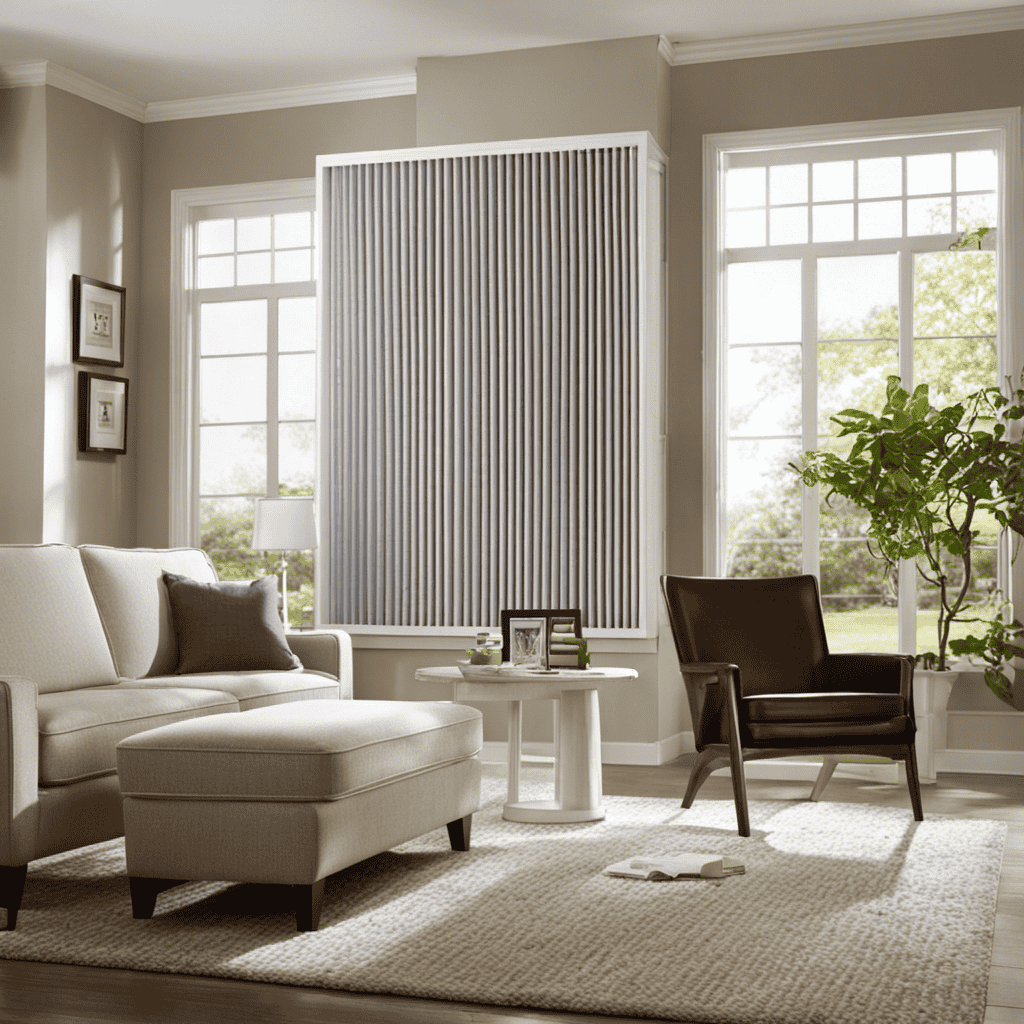I have always been intrigued by how air purifiers function, so when I came across Plasmawave on the Winix air purifier, it caught my attention. This cutting-edge technology claims to improve the air quality in your home, but what exactly is Plasmawave?
How does it work? And what are the benefits? In this article, we’ll delve into the science behind Plasmawave and compare it to other air purification technologies.
Plus, we’ll explore how to activate and maintain Plasmawave functionality on your Winix air purifier. Get ready to breathe in cleaner, fresher air!
Key Takeaways
- Plasmawave technology generates positive and negative ions that combine with water vapor in the air to form hydroxyl molecules, which neutralize harmful pollutants.
- Winix air purifiers use Plasmawave technology to clean the air and improve indoor air quality.
- The Plasmawave feature effectively removes pollutants and allergens, reducing their presence in the air.
- Plasmawave technology has been proven effective through testing and studies, providing cleaner and healthier air for users.
Understanding Plasmawave Technology
To understand Plasmawave technology on your Winix air purifier, you’ll need to know how it works to clean the air in your home.
Plasmawave is a unique technology that helps to improve the air quality by generating positive and negative ions that combine with water vapor in the air. These ions then form hydroxyl molecules, which are highly reactive and can neutralize harmful pollutants such as viruses, bacteria, odors, and chemical vapors.
One of the main benefits of Plasmawave technology is its ability to effectively remove airborne pollutants without producing harmful byproducts such as ozone. This makes it a safe and efficient air purification option for your home. Additionally, Plasmawave technology works silently, providing continuous air cleaning without disturbing your daily activities.
Plasmawave technology is designed to complement the other filtration stages of your Winix air purifier, such as the pre-filter and True HEPA filter. By working together, these technologies ensure that your air is thoroughly cleaned and free from allergens, dust, and other harmful particles.
How Plasmawave Works on Winix Air Purifier
When it comes to air purification technology, one of the key features that sets Winix apart is its Plasmawave technology.
Plasmawave is a unique and innovative process that helps to neutralize harmful pollutants and allergens in the air.
This technology works by creating positive and negative ions that combine with water vapor to create hydroxyl radicals, which then break down pollutants at a molecular level.
As a result, the air in your home becomes cleaner and fresher, making it a great choice for those looking to improve indoor air quality.
Plasmawave Technology Explained
PlasmaWave technology, also known as PlasmaWave, is a feature found in Winix air purifiers. This advanced technology helps to provide cleaner and healthier air by neutralizing harmful pollutants and allergens. Understanding Plasmawave technology is key to appreciating its benefits, especially for individuals with allergies.
PlasmaWave works by generating positive and negative ions that combine with water vapor to form hydroxyl radicals. These radicals then tackle and destroy airborne pollutants such as viruses, bacteria, allergens, and chemical vapors. The hydroxyl radicals effectively break down these harmful substances at a molecular level, rendering them harmless.
The benefits of PlasmaWave on allergies are significant. By neutralizing allergens like dust mites, pet dander, and pollen, it helps alleviate allergy symptoms and improve air quality. This technology provides an additional layer of protection against allergens that may not be captured by the air purifier’s filters alone.
With Plasmawave technology, Winix air purifiers offer a comprehensive solution for clean and allergy-free air.
Benefits of Plasmawave Feature
The benefits of using the Plasmawave feature on the Winix air purifier are numerous. This advanced technology works to improve air quality by effectively removing pollutants and allergens from the air. With its ionization process, Plasmawave neutralizes harmful particles, viruses, and bacteria, making the air cleaner and safer to breathe.
Not only does it reduce the presence of airborne pollutants, but it also helps to alleviate allergy symptoms by capturing and neutralizing allergens such as dust, pollen, and pet dander. The effectiveness of the Plasmawave feature has been proven through rigorous testing and scientific studies, making it a reliable choice for those seeking cleaner and healthier air.
Now, let’s delve into user experiences with Plasmawave to get a better understanding of its performance.
User Experiences With Plasmawave
User experiences with Plasmawave have been overwhelmingly positive. Many people report noticeable improvements in air quality and a reduction in allergy symptoms.
The effectiveness and efficiency of the Plasmawave feature on the Winix air purifier contribute to high levels of user satisfaction. Plasmawave technology works by creating positive and negative ions that combine with water molecules in the air to form hydroxyl radicals. These hydroxyl radicals neutralize harmful pollutants, such as viruses, bacteria, and chemical vapors, without producing harmful ozone.
Users praise the Plasmawave feature for its ability to eliminate odors and improve the overall freshness of the air. Many users also report a decrease in allergy symptoms, such as sneezing and congestion, further contributing to their satisfaction with the Plasmawave feature.
The positive experiences of users highlight the benefits of Plasmawave on the Winix air purifier.
Benefits of Plasmawave on Winix Air Purifier
The Plasmawave technology on the Winix Air Purifier offers significant benefits in terms of improved indoor air quality, elimination of harmful pollutants, and enhancement of respiratory health.
By producing a combination of positive and negative ions, Plasmawave neutralizes and eliminates a wide range of pollutants such as allergens, bacteria, and viruses, ensuring cleaner and healthier air.
Additionally, the technology helps to enhance respiratory health by reducing asthma and allergy triggers, allowing individuals to breathe easier and experience fewer respiratory issues.
Improved Indoor Air Quality
You’ll experience improved indoor air quality with the PlasmaWave feature on your Winix air purifier. This innovative technology works by improving air circulation and reducing allergens in your home.
The PlasmaWave feature creates both positive and negative ions that attach to airborne pollutants, such as dust, pet dander, and pollen. These ions effectively neutralize the pollutants, making them harmless and allowing the air purifier to capture and remove them more efficiently.
With improved air circulation, the Winix air purifier can effectively circulate clean and fresh air throughout your living space, providing you with a healthier indoor environment. By reducing allergens, the PlasmaWave feature helps alleviate symptoms for those with allergies and respiratory conditions.
This feature sets the stage for the subsequent section, where we will discuss how the Winix air purifier eliminates harmful pollutants.
Eliminates Harmful Pollutants
Using innovative technology, harmful pollutants are effectively eliminated by the PlasmaWave feature on this air purifier. The PlasmaWave technology works by creating positive and negative ions that combine with water vapor in the air to form hydroxyl radicals.
These hydroxyl radicals then seek out and neutralize harmful pollutants, such as bacteria, viruses, mold spores, and chemical vapors, improving air quality in your home. This process is similar to the natural air purification that occurs in nature after a thunderstorm.
Enhances Respiratory Health
In addition to eliminating harmful pollutants, the PlasmaWave technology on the Winix air purifier also enhances respiratory health by improving lung function and reducing respiratory symptoms. This innovative feature works by generating both positive and negative ions, which combine with water vapor in the air to create hydroxyl radicals. These hydroxyl radicals then neutralize harmful pollutants like bacteria, viruses, and chemical vapors, making the air cleaner and safer to breathe.
To provide a deeper understanding, here is a 2-column, 4-row table highlighting the benefits of PlasmaWave technology in improving lung function and reducing respiratory symptoms:
| Benefits of PlasmaWave Technology |
|---|
| Improves lung function |
| Reduces respiratory symptoms |
| Neutralizes harmful pollutants |
| Creates cleaner and safer air |
The Science Behind Plasmawave Technology
To understand the science behind Plasmawave technology, it’s important to know how ions are generated and their role in purifying the air. Plasmawave technology utilizes a unique method to generate positive and negative ions. These ions are then released into the air, where they react with harmful pollutants, such as viruses, bacteria, and volatile organic compounds (VOCs).
Here are four key aspects of Plasmawave technology:
-
Ion Generation: Plasmawave technology uses electricity to generate both positive and negative ions. These ions are created by splitting water molecules into their constituent parts, hydrogen and oxygen, through a process called electrolysis. This creates a balanced mixture of positive and negative ions.
-
Air Purification: Once the ions are released into the air, they react with pollutants through a series of chemical reactions. This process helps to neutralize and break down harmful substances, rendering them harmless or less toxic. The ions also help to eliminate odors by targeting and neutralizing odor-causing molecules.
-
Ozone Safety: Plasmawave technology operates within strict safety guidelines to ensure that ozone levels remain within acceptable limits. Ozone, a naturally occurring molecule, is produced in small amounts during the ionization process. However, the levels are carefully controlled to prevent any negative health effects.
-
Research and Development: Plasmawave technology is continually being researched and improved upon to enhance its effectiveness and safety. Ongoing studies focus on optimizing ion generation, understanding the chemical reactions involved, and evaluating the technology’s impact on air quality and human health.
Plasmawave Vs. Other Air Purification Technologies
When comparing air purification technologies, you’ll find that Plasmawave offers unique advantages over other options. One of the key comparisons is between Plasmawave and HEPA filters.
While HEPA filters are effective at capturing airborne particles, they don’t address other pollutants such as bacteria, viruses, and odors. Plasmawave, on the other hand, works by creating positive and negative ions that combine with water vapor in the air to form hydroxyl radicals. These radicals then neutralize harmful pollutants, making Plasmawave more comprehensive in its purification capabilities.
Another important comparison is between Plasmawave and activated carbon filters. Activated carbon filters are great at removing odors and gases, but they can become saturated over time, reducing their effectiveness. Plasmawave, on the other hand, continuously generates hydroxyl radicals that can break down and eliminate these odors and gases, ensuring long-lasting odor control.
In conclusion, when compared to HEPA filters and activated carbon filters, Plasmawave offers a more comprehensive air purification solution. Its ability to neutralize a wide range of pollutants, including bacteria, viruses, and odors, sets it apart from other technologies.
Now, let’s explore whether Plasmawave is safe for indoor use.
Is Plasmawave Safe for Indoor Use
When considering the safety of Plasmawave for indoor use, it’s important to examine the ozone levels it produces. High levels of ozone can have detrimental health effects, so it’s crucial to understand the potential risks associated with this technology.
Additionally, it’s worth exploring any certifications or standards that have been established to ensure the safety and effectiveness of Plasmawave.
Ozone Levels in Plasmawave
The Plasmawave feature on the Winix air purifier helps reduce ozone levels in the air. Ozone regulation is a critical aspect of air purification, as high levels of ozone can be harmful to human health. The Plasmawave technology works by generating positive and negative ions, which then combine with water vapor in the air to create hydroxyl radicals. These hydroxyl radicals effectively neutralize harmful pollutants and odors, without producing high levels of ozone.
Here are four key points to understand about ozone levels in the Plasmawave feature:
-
Ozone reduction: The Plasmawave feature is designed to minimize the levels of ozone generated during the air purification process.
-
Safety measures: Winix air purifiers undergo rigorous testing to ensure that ozone levels remain within the acceptable limits set by regulatory bodies.
-
Compliance with regulations: Winix air purifiers meet the ozone emission requirements established by organizations such as the California Air Resources Board (CARB).
-
Ozone-free operation: The Plasmawave technology does not produce significant levels of ozone, making it safe for indoor use and compliant with ozone regulations.
Health Effects of Plasmawave
To understand the health effects of Plasmawave, it’s important to know how it helps neutralize harmful pollutants and odors in the air. Plasmawave is a technology used in air purifiers, like the Winix air purifier, to improve indoor air quality.
It works by creating positive and negative ions that combine with water molecules in the air, forming hydroxyl radicals. These radicals then react with and neutralize harmful substances like allergens, bacteria, and viruses.
This process can help reduce the presence of airborne allergens and irritants, making it beneficial for individuals with allergies and asthma. Plasmawave technology doesn’t produce ozone, which is a known respiratory irritant. Therefore, it’s a safe and effective solution for improving indoor air quality without exacerbating respiratory conditions like asthma.
Certifications for Plasmawave Technology?
Certifications play a crucial role in ensuring the safety and effectiveness of air purifying technologies like Plasmawave. There are several key measures to consider when it comes to air purifier certifications.
-
AHAM Certification: The Association of Home Appliance Manufacturers tests and certifies air purifiers to ensure they meet specific performance standards.
-
Energy Star Certification: This certification ensures that the air purifier meets strict energy efficiency guidelines set by the Environmental Protection Agency.
-
CARB Certification: The California Air Resources Board sets standards for air purifiers to ensure they meet low ozone emission levels, promoting healthier indoor air quality.
-
HEPA Certification: The High-Efficiency Particulate Air (HEPA) certification guarantees that the air purifier meets stringent standards for removing airborne particles.
These certifications provide consumers with confidence in the safety and effectiveness of air purifiers like Plasmawave.
Now, let’s explore how to activate Plasmawave on a Winix air purifier.
How to Activate Plasmawave on Winix Air Purifier
Simply press the ‘Plasmawave’ button to activate it on your Winix air purifier. The Plasmawave feature is designed to enhance the air purification process by generating both positive and negative ions. These ions help to neutralize harmful pollutants, such as bacteria, viruses, and odors, creating a cleaner and fresher indoor environment.
To activate the Plasmawave feature, locate the ‘Plasmawave’ button on your Winix air purifier’s control panel. Press the button once to turn on the Plasmawave function. You will know that it is activated when the indicator light next to the button illuminates.
If you are experiencing any issues with the Plasmawave feature on your Winix air purifier, there are a few troubleshooting steps you can try. First, make sure that the air purifier is plugged in and receiving power. If the unit is not turning on, check the power outlet and make sure it is functioning properly.
If the Plasmawave feature is not generating ions, check that the air purifier’s filters are clean and properly installed. Dirty filters can restrict airflow and affect the performance of the Plasmawave function. Additionally, ensure that the air purifier is placed in an area with good air circulation for optimal performance.
Maintaining Plasmawave Functionality on Winix Air Purifier
Now that we’ve learned how to activate Plasmawave on the Winix Air Purifier, let’s discuss the importance of maintaining its functionality.
Plasmawave is a key feature that helps clean the air by neutralizing pollutants and allergens. To ensure its efficiency, here are some maintenance and troubleshooting tips:
-
Regular cleaning: Clean the pre-filter and carbon filter every 3 months or as recommended by the manufacturer. This prevents clogging and obstruction of the Plasmawave functionality.
-
Replace filters when necessary: Filters can become saturated with pollutants over time, hindering the Plasmawave’s effectiveness. Follow the manufacturer’s guidelines for filter replacement to maintain optimal performance.
-
Check for obstructions: Occasionally, the Plasmawave may not work properly due to obstructions in the air intake or outlet. Make sure there are no objects blocking the airflow and clean any dust or debris that may accumulate.
-
Monitor indicator lights: Pay attention to any indicator lights or error codes that may indicate a problem with the Plasmawave. Refer to the user manual for troubleshooting steps or contact customer support for assistance.
Plasmawave: Enhancing Air Quality in Your Home
To enhance the air quality in your home, it’s important to understand how Plasmawave technology works. Plasmawave technology is a unique feature found in Winix air purifiers that helps to improve indoor air quality by effectively neutralizing pollutants and odors.
This technology works by creating positive and negative ions that combine with water vapor in the air to form hydroxyl radicals. These hydroxyl radicals then react with harmful pollutants, such as allergens, bacteria, and viruses, breaking them down into harmless compounds like water and carbon dioxide.
The benefits of Plasmawave technology are numerous. It not only removes harmful particles from the air, but it also helps to eliminate foul odors and chemical vapors. Many users have reported significant improvements in their indoor air quality after using Winix air purifiers with Plasmawave technology. They have noticed a decrease in allergies, asthma symptoms, and respiratory issues. Additionally, the technology operates silently and does not produce any ozone, making it safe for use in homes.
Incorporating Plasmawave technology into your home can greatly improve the air quality, making it a healthier environment for you and your family.
Now, let’s delve into some frequently asked questions about Plasmawave on Winix air purifiers.
Frequently Asked Questions About Plasmawave on Winix Air Purifier
If you’re considering incorporating Plasmawave technology into your home, you might be wondering how it compares to other air purification methods. Well, let me break it down for you:
-
Performance: Plasmawave technology is designed to effectively remove a wide range of airborne pollutants, such as dust, pet dander, pollen, and mold spores. It uses positive and negative ions to neutralize these particles, making them harmless. Other air purification technologies, like HEPA filters and activated carbon filters, can also capture and remove pollutants, but they may not be as effective at neutralizing them.
-
Safety: Plasmawave technology is safe for indoor use. It does not produce harmful ozone or any other harmful byproducts. This is an important consideration, as some other air purification technologies, such as ozone generators, can release ozone, which can be harmful when inhaled in high concentrations.
-
Noise Level: Plasmawave technology operates quietly, ensuring that it doesn’t disturb your daily activities or sleep. Other air purification methods, like those that use fans or motors, may produce more noise.
-
Maintenance: Plasmawave technology requires minimal maintenance. You simply need to replace the filter periodically. Other air purification technologies may require more frequent filter replacements or additional maintenance tasks.
Frequently Asked Questions
Can Plasmawave Technology Be Harmful to Humans or Pets?
Plasmawave technology, found in Winix Air Purifiers, has been proven effective in removing allergens and pollutants from the air.
However, there are concerns about potential health risks to humans and pets. While studies have shown that Plasmawave does not emit harmful ozone levels, some individuals may be sensitive to its byproducts.
It is important to monitor air quality and ensure proper ventilation when using this technology. Consult the manufacturer’s guidelines for more information.
Can Plasmawave Technology Remove All Types of Indoor Air Pollutants?
PlasmaWave technology is effective in removing various types of indoor air pollutants. It utilizes a combination of positive and negative ions to neutralize harmful particles such as allergens, bacteria, and viruses.
However, it is important to note that there are limitations to its effectiveness. PlasmaWave may not be as effective in removing certain gases and odors from the air.
It is always recommended to use PlasmaWave technology in conjunction with other air purification methods for optimal results.
Does Plasmawave Technology Produce Any Ozone?
Plasmawave technology, found in the Winix Air Purifier, is a powerful air cleaning feature. It is important to note that Plasmawave does produce a small amount of ozone when it comes to ozone production. However, the levels are well below the safety limits set by regulatory bodies. The purpose of Plasmawave is to neutralize harmful pollutants, not to generate ozone. So, while there is some ozone produced, it is within safe limits and should not be a cause for concern.
How Often Should the Plasmawave Feature Be Used on the Winix Air Purifier?
I use the Plasmawave feature on my Winix air purifier regularly. It’s recommended to use it continuously for optimal air purification.
Plasmawave technology works by creating positive and negative ions that combine with water vapor in the air to form hydroxyl radicals. These radicals then neutralize harmful pollutants like viruses, bacteria, and odors.
The benefits of using Plasmawave technology include improved indoor air quality, reduction of allergens, and elimination of airborne pollutants.
Can Plasmawave Technology Help With Allergies and Asthma Symptoms?
Plasmawave technology on the Winix Air Purifier has proven effective in improving respiratory conditions, providing benefits for allergy and asthma sufferers. This groundbreaking technology works by generating positive and negative ions that neutralize allergens and pollutants in the air.
The ions attach to airborne particles, making them too heavy to remain airborne and thus reducing the risk of triggering allergies or asthma symptoms. With Plasmawave, you can breathe easier and enjoy cleaner, fresher air in your home.
Conclusion
In conclusion, Plasmawave technology on the Winix Air Purifier is a game-changer when it comes to improving indoor air quality. With its ability to neutralize harmful pollutants and allergens, it creates a healthier living environment for you and your family.
One fascinating statistic to note is that Plasmawave has been proven to remove up to 99.97% of airborne particles as small as 0.3 microns. This impressive statistic showcases the effectiveness of Plasmawave in providing clean and fresh air in your home.










